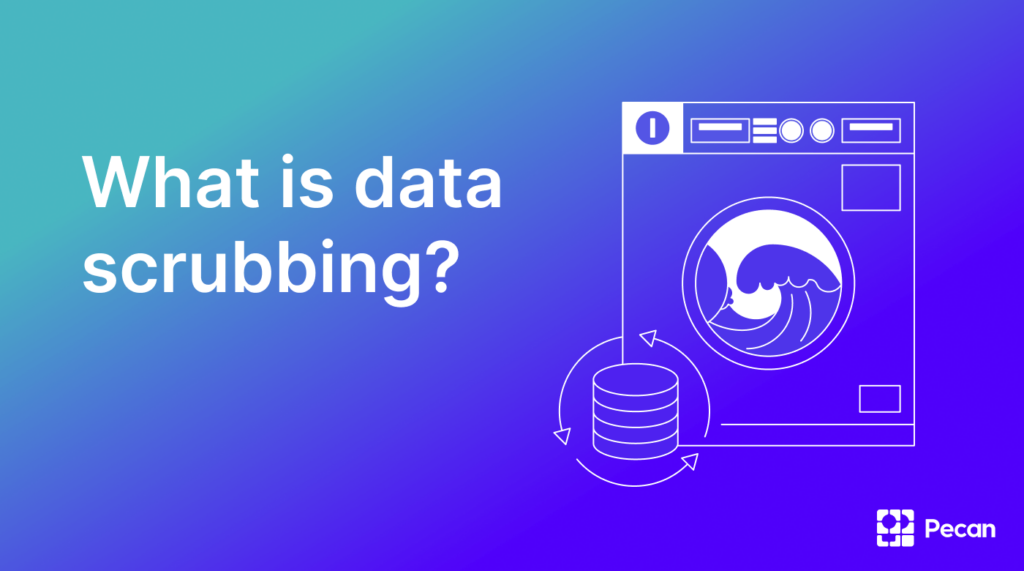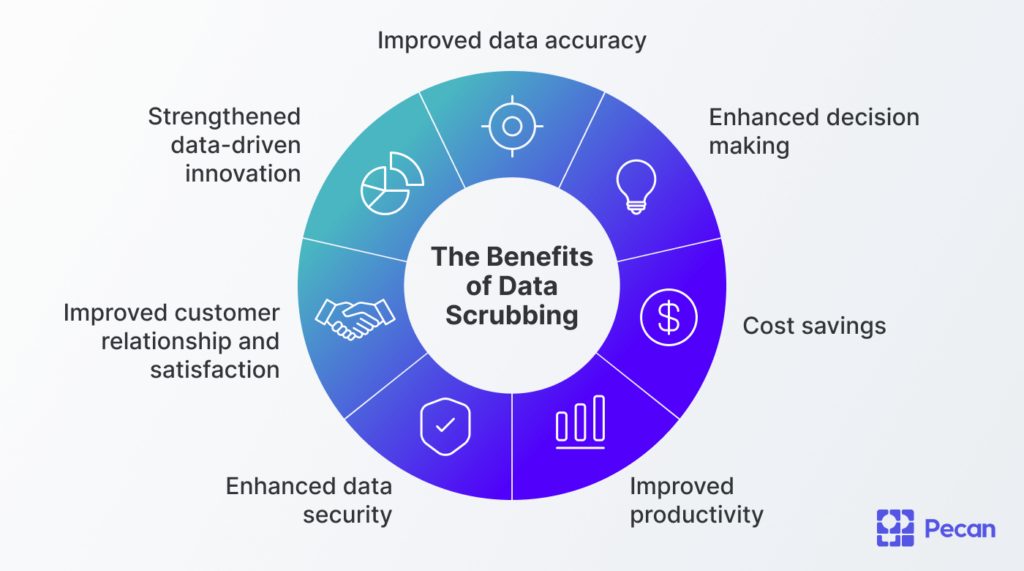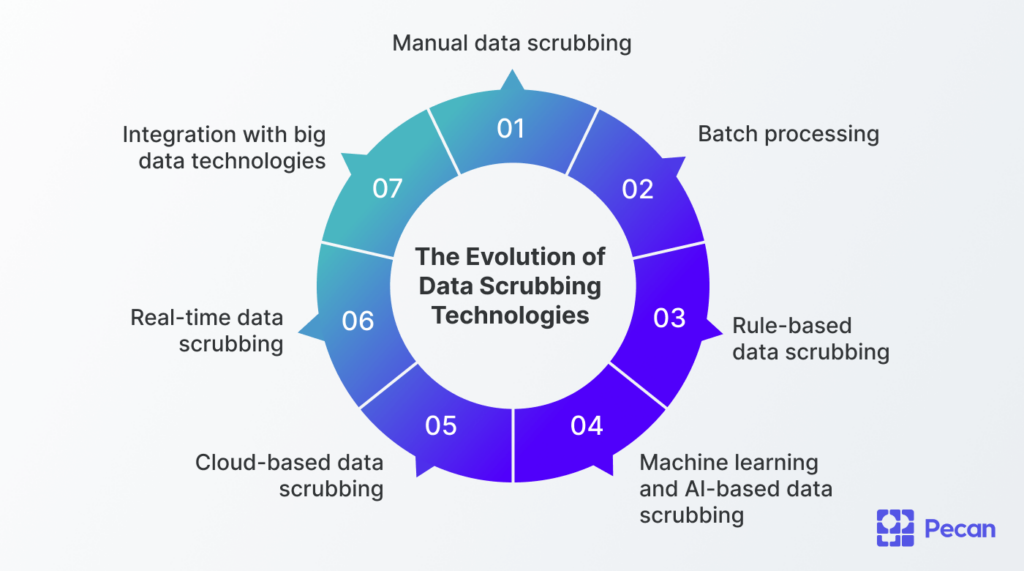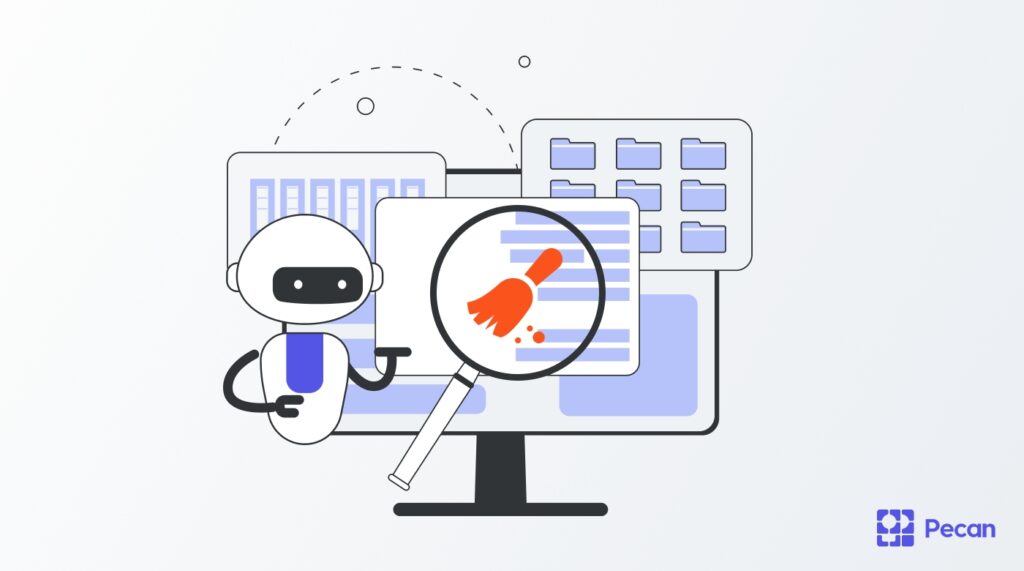More data isn’t always the solution. Ensuring that the data collected is high-quality and usable is equally important. In fact, up to 80 percent of data generated by companies ends up being wasted. This is where data scrubbing comes in. It’s an important stage in getting information about your business’s growth.
In this article, we'll discuss what data scrubbing is, the benefits of data scrubbing, and the common causes of data contamination. We’ll also talk about the processes involved in data scrubbing and how you can collect, scrub, and analyze your company’s data with AI alternatives to tedious, time-consuming manual data scrubbing processes.
What is data scrubbing?
Data scrubbing is the process of identifying and solving errors and inaccuracies within datasets. It involves detecting errors, removing duplicates, standardizing formats, and updating outdated information. The primary objective of data scrubbing is to improve the accuracy and reliability of data, which forms the basis for making informed business decisions.
In data management, terms like data scrubbing, data cleaning, and data cleansing are often used interchangeably, which can lead to confusion. Let’s explain the differences between these concepts.
What’s the difference between data scrubbing, data cleaning, and data cleansing?
While these terms are often used interchangeably, they do have different meanings:
- Data Scrubbing: Data scrubbing focuses on pinpointing and correcting errors within datasets, ensuring data accuracy. It helps prevent inaccuracies from impacting business decisions.
- Data Cleaning: Data cleaning is a broader process that deals with tasks beyond error correction. It includes validation, transformation, and enrichment of data.
- Data Cleansing: Data cleansing goes deep into datasets to address problems such as outdated information and incomplete records. Data cleansing improves overall data quality and makes it usable for specific business needs.
Understanding these differences is important for businesses looking to get accurate, consistent, and reliable data. This leads to better business decisions.
What are the benefits of data scrubbing?
Data scrubbing serves a lot of important functions. Here are seven reasons data scrubbing is an essential step in data management:
1. Improved data accuracy
Every successful business operation needs accurate data. Data scrubbing helps identify and correct inaccuracies, errors, and inconsistencies in databases. These inaccuracies can lead to wrong decisions, financial losses, and tarnished customer relationships. Scrubbed data helps form a reliable foundation for strategic planning and informed decision-making, fostering trust both internally and externally.
2. Enhanced decision-making
Clean, error-free data equips decision-makers with reliable insights. According to this study, 84 percent of respondents claim that data will become the biggest factor to consider when making business decisions within the next five years.
Whether optimizing supply chains, analyzing market trends, or identifying customer preferences, accurate data enhances business intelligence. In marketing, understanding customer behaviors and preferences is important. Clean data allows for targeted marketing efforts, improving customer engagement and campaign effectiveness.
3. Cost savings
Data errors can lead to costly mistakes, such as shipping errors, stock mismanagement, or misguided marketing campaigns. For instance, mailing incorrect information to customers, investing in marketing campaigns based on flawed data, or dealing with errors in inventory management can lead to financial losses. Data scrubbing prevents these risks and leads to significant cost savings.
It helps prevent unnecessary spending and loopholes, allowing businesses to allocate resources wisely.
4. Improved productivity
Unclean data is essentially useless. Every year, poor data quality costs organizations an average of $12.9 million. Without proper scrubbing, 69 percent of data leaders admit that the inability to extract value from data is holding back their company’s digital transformation. Data scrubbing helps improve processes and reduces time spent on fixing errors and verifying data. This allows staff to focus on important tasks and enhances overall productivity.
Marketing teams, in particular, benefit from efficient data management. Clean customer data facilitates targeted marketing strategies. This guarantees that promotional efforts reach the right audience and enhance campaign efficiency.
5. Enhanced data security
Data breaches pose huge risks to businesses. Data scrubbing corrects errors and strengthens data security. By identifying security loopholes, companies can protect their data against unauthorized access and ensure customer confidentiality. This enhanced security protects the business from legal and financial troubles and builds customer trust.
6. Improved customer relationship and satisfaction
Data scrubbing significantly improves the quality of data used for analytical purposes. By ensuring data accuracy, your business is able to generate precise reports, conduct in-depth analyses, and identify meaningful patterns.
Whether it's market trend analysis, forecasting sales, or measuring the success of marketing campaigns, accurate data obtained through scrubbing enables businesses to strategize properly. This, in turn, leads to better-targeted campaigns, improved resource allocation, and a competitive edge in the market.
7. Strengthened data-driven innovation
Data scrubbing unleashes the potential for innovation within businesses. Scrubbed data forms the basis for advanced technologies like machine learning and artificial intelligence. These technologies thrive on reliable data to create predictive models, automate processes, and identify trends. By ensuring the quality of data through data scrubbing, businesses can use these innovations effectively.
For instance, in e-commerce, scrubbed customer data can be used to develop recommendation algorithms, improving personalized shopping experiences. Scrubbed data serves as the raw material for innovation, allowing businesses to explore new avenues and create innovative products.
Common causes of data errors
Data errors affect the reliability of databases and can render them useless if they aren't fixed. Common causes of data error include:
1. Merging databases
When merging multiple databases during processes like system integrations, there’s an increased possibility that data errors will occur. This can be a result of different data structures and formats being merged together, which leads to errors within the integrated dataset.
2. Human error
People are often one of the major sources of data errors. Data entry mistakes, such as typographical errors or misinterpreting information, can result in incorrect or incomplete data. There’s also the likelihood of inputting the same information multiple times, which can further compound data errors.
3. Lack of data standardization
As data is often collected from several sources, a lack of standardized formats and protocols can lead to lots of problems. These errors include variations in data formats and measurement units. This can cause huge errors in the interpretation and analysis of the collection data. Creating a standardized process for saving and formatting databases is essential to ensuring uniformity and consistency across datasets.
4. Outdated data
Data, much like the world it represents, is constantly changing. Outdated information poses a significant risk to businesses. When the right updates aren't made on time, databases may contain irrelevant or inaccurate data, which leads to inefficiency and misguided decisions.
5. Inadequate data security
Data security breaches don’t only affect client confidentiality, they also lead to inaccuracies and data errors. It is important to take special care to protect databases against unauthorized modifications and safeguard them from external threats.
The evolution of data scrubbing technologies
Data scrubbing technologies have changed over the years:
1. Manual data scrubbing
In the early days of computing, data cleansing was a manual process. Data analysts and operators would identify inconsistencies and errors in databases and correct them by hand. While this method was labor-intensive and time-consuming, it laid the foundation for more automated approaches.
2. Batch processing
As computing power increased, batch processing systems were introduced. These systems allowed data cleaning tasks to be automated to some extent. Data scrubbing algorithms were developed to identify and correct errors in large datasets. While faster than manual methods, batch processing systems still had limitations regarding real-time data cleaning.
3. Rule-based data scrubbing
Rule-based data cleansing systems emerged, where predefined rules and algorithms were applied to identify common data errors and inconsistencies. These systems allowed for the automation of such processes to a higher degree, allowing for more efficient and accurate data cleaning. However, they were limited in handling complex and non-standard data issues.
4. Machine learning and AI-based data scrubbing
With advancements in machine learning and artificial intelligence, data scrubbing techniques entered a new era. Machine learning algorithms were trained to recognize patterns in data and automatically correct errors and inconsistencies. AI-based systems could handle various data issues, including unique errors that traditional rule-based systems struggled with. These AI systems also improved in accuracy over time as they learned from more data.
5. Cloud-based data scrubbing
Cloud-based data scrubbing services have become popular, allowing businesses to access powerful data cleansing tools without needing extensive hardware and software investments. These services often combine AI-based algorithms with scalable cloud infrastructure, providing companies with flexible and efficient data cleaning solutions.
6. Real-time data scrubbing
Modern data scrubbing technologies now offer real-time capabilities. Businesses can clean and validate data as it is generated or entered into systems. Real-time data scrubbing ensures the data used for decision-making is always accurate and up-to-date. This is crucial in industries where real-time analytics and insights are essential.
7. Integration with big data technologies
Data scrubbing technologies have integrated with big data platforms. Businesses dealing with massive volumes of data can now leverage data scrubbing tools specifically designed to handle big data challenges. These tools can clean, validate, and transform vast datasets efficiently, enabling organizations to derive meaningful insights from their data.
Data scrubbing technologies have progressed from manual methods to sophisticated, real-time, and AI-driven solutions. These advancements have improved the reliability of data and made the process more efficient and accessible to businesses of all sizes.
Automate your data scrubbing process with the low-code Pecan AI platform
One of the core challenges businesses face is harnessing the power of their data effectively. According to this Seagate report, the top barriers to putting data to work are making collected data usable and managing the storage of the data. In response to these challenges, innovative solutions like Pecan are revolutionizing the data management landscape.
Pecan AI is a leading pioneer in AI predictive modeling, offering businesses a streamlined approach to utilizing their data effectively. With its intuitive, low-code structure, Pecan empowers users to automate their data scrubbing process without requiring extensive coding knowledge — while also adding far more powerful capabilities in predictive analytics. This is made possible through its user-friendly interface, which ensures that even those unfamiliar with complex technicalities can use the platform with ease.
Benefits of using an AI data System
Embracing an AI data system like Pecan unlocks several advantages. Its intuitive nature significantly reduces the learning curve, allowing businesses to adapt to the platform swiftly. This efficiency translates to time and cost savings for different types of businesses. Rather than spending time and resources on stressful data-cleansing tasks, Pecan automatically handles it for you.
A key feature of Pecan is its tailored predictive analysis, which empowers businesses to uncover valuable insights specific to their industry and objectives. Using AI and machine learning, Pecan can identify patterns and trends within datasets. This allows them to anticipate market trends, customer behaviors, and emerging opportunities, staying several steps ahead of their competition.
Pecan is also well known for its seamless integration with various software applications commonly used in business operations. This promotes smooth data flow between systems and enhances overall operational efficiency. Whether it's integrating customer relationship management (CRM) software or financial analytics tools, Pecan acts as the connective tissue, unifying several data sources into an integrated dataset.
Automating the data cleansing process and offering tailored predictive analysis propels businesses toward a future where data becomes a strategic asset rather than a hurdle. Embracing Pecan signifies a technological upgrade and a transformative journey toward smarter, data-driven decision-making and sustainable business growth.
Take your data scrubbing process to the next level
Data scrubbing is a vital part of any data management process. Without it, most data is unusable. However, for most small and medium enterprises (SMEs), engaging the services of a professional data scientist may be too expensive. That’s why we recommend using AI-powered, low-code data platforms such as Pecan. With little coding experience, your entire team can easily compile, scrub, analyze, and use data. More importantly, they can accurately predict your customers’ future activities with AI, leading to better business outcomes and more profit.
Get started with Pecan today to automate your data management process.









